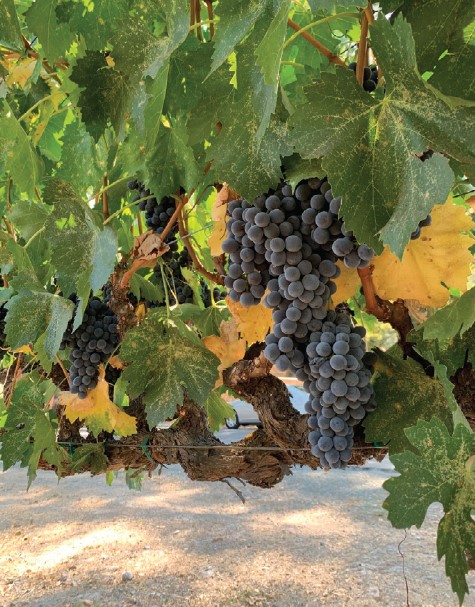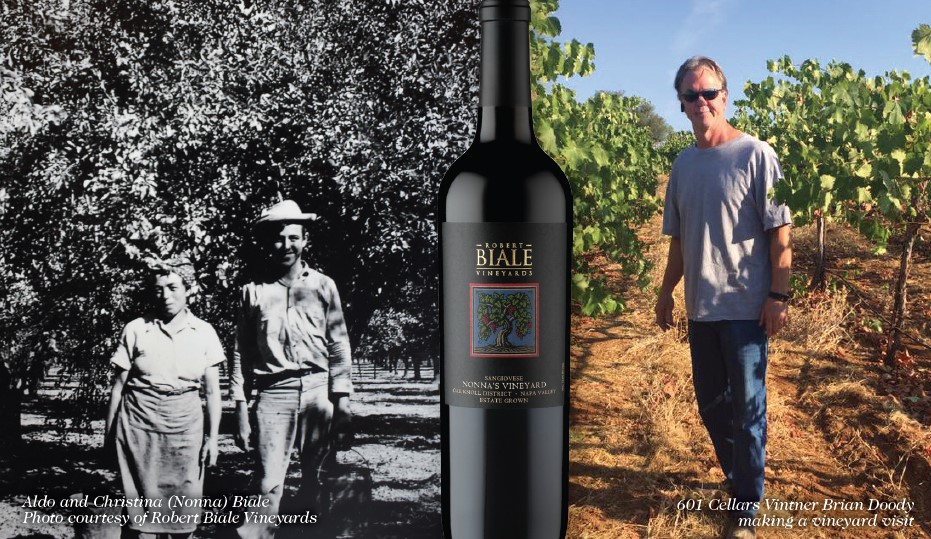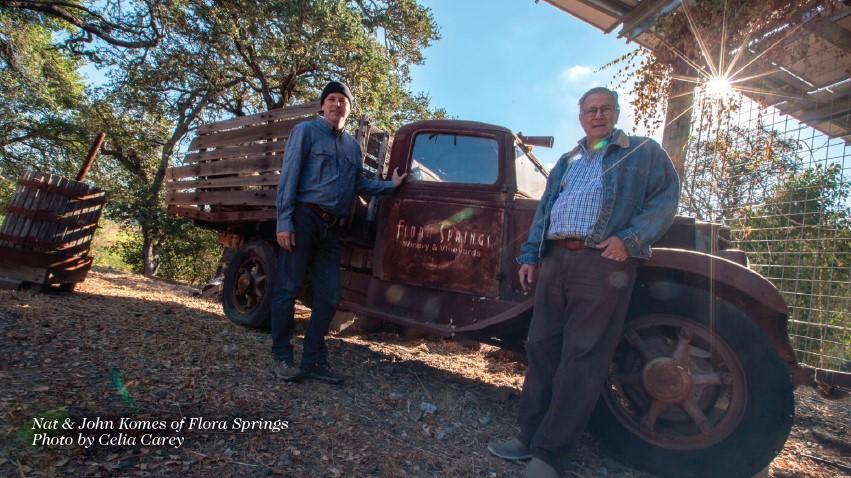Story By: Melissa Vogt
Small Parcels Yield Rare Gems
Napa Valley is synonymous with Cabernet Sauvignon, so why do producers craft wines from varietals that seem “out of place” for the region? Although Napa Valley has hung its hat—for good reason—on Cabernet, the region’s diverse terroir is what allows for the wide range of varietals that successfully grow in the right microclimates. Add that to passion and talent, and a great viticulturist can team up with an experienced winemaker to turn a non-Cabernet varietal into a truly fantastic Napa Valley wine.
Enter Sangiovese. This thin-skinned grape variety can be tricky to grow, but select Napa Valley producers have mastered the art of crafting this finicky grape into spectacular wine. It’s a grape that grows prolifically in fertile soils, which is why Napa producers need to be careful about where they plant it. “We have learned a great deal over the last 35 years of having Sangiovese planted on the Antica estate,” said Glenn Salva, wine estate manager of Antica Napa Valley. “Even within Tuscany, Sangiovese is not grown in all areas.”
Sangiovese is native to the Tuscan region in Italy, where it’s made in many styles, including light and bright with fresh acidity to darker and more complex with the ability to age. In its lightest and most food-friendly expression, Tuscan Sangiovese is offered as a table wine at every meal. In historically classified and recognized regions such as Chianti and Brunello di Montalcino, Sangiovese takes on more clout. As Chianti, Sangiovese still retains its light and bright style and is a go-to wine for everyday enjoyment. As Brunello di Montalcino, price, quality, complexity, and acquisition rise significantly—Sangiovese reaches the pinnacle of quality and recognition as Brunello. Because the wines are required to be aged for at least two years in barrel and then aged in bottle for a minimum of four months before release, their style is wholly different from other expressions of Sangiovese.
Napa Valley producers have followed suit, crafting a range of Sangiovese. For Salva and his team at Antica Napa Valley, they are no strangers to the diversity of Sangiovese. Owned by the Italian Antinoris, Antica Napa Valley is the family’s only vineyard holding outside of Italy—and while it’s mostly planted to Cabernet Sauvignon, the family is passionate about its small plot of Sangiovese. The estate’s name, a literal blend of Antinori and California, is a representation of their Italian heritage combined with their desire to produce world-class California wine as a complement to their reputable Italian portfolio.
It was 1986 when Piero Antinori first planted Sangiovese vines at the Antica estate. He wanted to “see how his historic Tuscan variety would grow in Napa Valley,” stated Salva. And although the grape proved sensitive, the family’s discipline and talent have yielded a remarkable version of this Italian grape. “The small amount of Sangiovese grown on the Antica estate has made us better viticulturists and winemakers. When these skills are properly applied, the resulting wine is delicious, offering Sangiovese typicity,” Salva said. // www.antica.com
Other Napa Valley estates have managed to grow Sangiovese with classic characteristics as well, such as Castello di Amorosa with their 2018 Voyager Vineyard Sangiovese. It’s a Sangiovese that’s wholly correct in varietal style with fresh red cherry and dried strawberry on the nose, bright red fruit, energetic acidity, and a gentle tannic structure on the palate. “With Sangiovese being one of the classic Italian wine grapes from Tuscany, it was natural for Dario to grow this variety,” said Castello di Amorosa winemaker Peter Velleno, “and he was not afraid to use his prized Napa Valley estate to do so.” Velleno agrees that the diversity of soils and microclimates in Napa Valley are what allow for the “perfect combination of conditions to match just about any variety,” he said. // www.castellodiamorosa.com
Italian heritage, passion for the varietal, and faith in Napa’s terroir are the threads that tie together Sangiovese producers across the Valley. Bob Biale, Founder of Robert Biale Vineyards, admits: “My father, Aldo, and Nonna, Cristina, loved Sangiovese and enjoyed it with dinner.” Their 2020 Nonna’s Sangiovese is an Oak Knoll appellation wine and a member’s only offering. Made from exactly one acre of Sangiovese that the family planted in 1995, this Sangiovese is undoubtedly one of the most limited-production expressions you can find. “I think many people are attracted to well-made, rare gems that are not commonly grown in Napa Valley,” said Biale, and he’s got a point. Those looking for unique and exclusive wines like this are apt to sign up for the wine club. // www.biale.com
Another family-owned winery whose core portfolio is small-lot Sangiovese is 601 Cellars. Brian Doody is the proprietor and winemaker, and he and his co-proprietor wife, Laura Larson, seek out exclusive vineyards for their wine production. “Since we are a very small producer, we have the luxury of being able to source our grapes from some of Napa’s premier vineyards,” stated Doody. Named after their elopement in Italy in June 2001 (601) combined with their passion for Old World style wines, the duo focuses strictly on Sangiovese and Grenache production, for which they have received Best in Class industry accolades and multiple gold medals. “Napa has become oversaturated with big Cabs at escalating prices, so we’re targeting a more approachable and adventurous niche of wine lovers who, like us, want to get off the grid and try something different. We see no reason to feel guilty about opening a fantastic bottle of Napa Valley wine with a pizza on Tuesday night,” said Doody. Their 2018 Sangiovese Reserve from Napa Valley expresses a spicy plum and red cherry-filled palate with fresh acidity, hailing to an elegantly balanced expression of a Chianti Classico. For their Cabernet-loving fans, they produce a bolder-style Napa Valley Sangiovese Super Tuscan blend (80% Sangiovese, 12% Merlot, 8% Cabernet Sauvignon). They also produce a lighter style Sangiovese from the Sierra Foothills. // www.601cellars.com
At Flora Springs Winery, General Manager Nat Komes admits that they have “found the southern part of the valley to be a good area for Sangiovese.” Komes stands by the cool breezes in southern Napa Valley blowing up from the San Pablo Bay as one of the main factors for helping their Sangiovese retain the quintessential acidity for which the grape is known. Much like Laura and Brian from 601 Cellars, Komes’ family has a “fell in love” with Sangiovese memory from a trip to Tuscany. “Our Napa Valley Sangiovese stands out primarily because it is becoming so rare,” Komes stated. The estate’s 2019 Sangiovese is a member’s only wine packed with cherry, pomegranate, and red plum—it’s well worth signing up to get your hands on this bottle. // www.florasprings.com
Whether it’s an Italian heritage, a serious affinity for Sangiovese, or a trip to Italy that served as inspiration, local producers are crafting beautiful expressions of Sangiovese right here in Napa Valley. As for the growers and vintners who produce these rare gems from the remaining small vineyard parcels, they all seem to share the same passion and purpose: to hold tight and make truly enjoyable wines in a region that’s ripe for varietal diversity.



